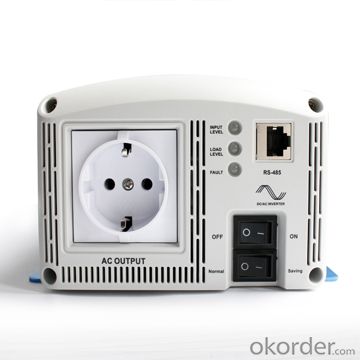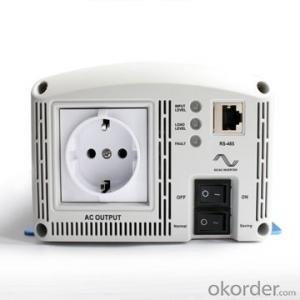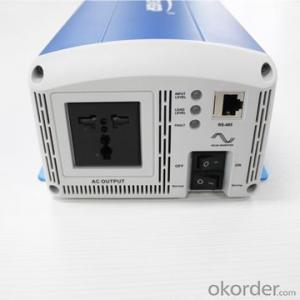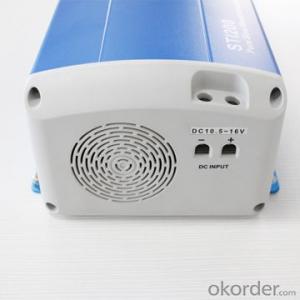Off-Grid Pure Sine Wave Solar Inverter 200W, DC 12V to AC 220/230V,STI200
- Loading Port:
- China Main Port
- Payment Terms:
- TT or LC
- Min Order Qty:
- -
- Supply Capability:
- -
OKorder Service Pledge
OKorder Financial Service
You Might Also Like
Description
STI series is a sine wave power frequency inverter which can convert 12V or 24V DC to 220VAC or 230VAC 50Hz based on full digital and intelligent design. The inverter can be applied in many fields especially for solar photovoltaic power system.

Features:
·Complete isolation-type inverter technology, noiseless output
·Adoption of advanced SPWM technology, pure sine wave output
·Dynamic current loop control technology to ensure inverter reliable operation.
·Wide DC input voltage range
·Excellent EMC design
·Low output harmonic distortion(THD≤3%)
·LED indicators display input voltage range, load power range, normal output & failure state
·Optional energy saving mode
·Wide working temperature range (industrial level)
·Continuous operation at full power
Protections:
·Output Short Circuit protection
·Overload protection
·Input reverse polarity protection
·Input low voltage protection
·Input over voltage protection
·Inverter abnormal protection
·Overheating protection


Specification:
Model | STI200-12-220 | STI200-24-220 | |
STI200-12-230 | STI200-24-230 | ||
Nominal battery voltage | 12V | 24V | |
Input voltage range | 10.5~16V | 21~32V | |
Consumption no load(ON) | ≤4W | ≤5W | |
Consumption no load (Saving) | ≤2W | ≤2W | |
Output voltage | AC220/230V±3% | ||
Continuous power | 200VA | ||
Power 10sec | 300VA | ||
Power 1.5sec | 400VA | ||
Surge power | 640VA | ||
Output mode | Single Phase | ||
Wave form | Pure Sine Wave | ||
Frequency | 50Hz±0.2% | ||
Distortion THD ( resistive load) | ≤ 3% | ≤ 2% | |
Efficiency at rated power | ≥81% | ≥85% | |
Max. efficiency | ≥88% | ≥89% | |
Dimension | 315*166*101mm | ||
Net weight | 4.5kg | ||
Working temperature | -20℃~ +50℃ | ||
Humidity | < 95%(non-condensation) | ||
Altitude | < 5000m(Derating to operate according to IEC62040 at a height exceeding 1000 m) | ||
FAQ
Does inverter long warranty mean high quality?
The European Sunny Boys are only warrantied for 5 years. iPhones only have a one year warranty. Does that mean Apple products aren't reliable? Enphase offers a 25 year warranty on their inverters but only one year on their monitoring. Does this mean their monitoring is not as reliable as their inverter? Of course not.
Offering long warranties have very real costs. If we were to offer a 25 year warranty, we would have to hold a higher reserve on our balance sheet, making our products more expensive. We think that our customers would rather have our high quality products at a lower cost.
- Q:How do you calculate the efficiency of a solar inverter?
- To calculate the efficiency of a solar inverter, you need to divide the output power by the input power and multiply the result by 100 to get a percentage. The formula is: Efficiency = (Output Power / Input Power) * 100.
- Q:Can a solar inverter be used in parallel configurations for increased power output?
- Yes, a solar inverter can be used in parallel configurations to increase power output. By connecting multiple inverters in parallel, the total power output can be increased, allowing for more efficient utilization of the solar energy generated. This parallel configuration allows for better distribution of the power load and helps to achieve a higher overall system capacity.
- Q:What is the maximum AC output current that a solar inverter can provide?
- The maximum AC output current that a solar inverter can provide depends on the specific model and capacity of the inverter. In general, it is determined by factors such as the maximum power rating and efficiency of the inverter, as well as the size and configuration of the solar photovoltaic (PV) system it is connected to.
- Q:How do you choose the right brand of solar inverter?
- When choosing the right brand of solar inverter, several factors should be considered. First, look for a brand with a good reputation and a track record of reliability. It's important to choose a brand that has been in the market for some time and has positive customer reviews. Additionally, consider the warranty and after-sales service provided by the brand. Look for a brand that offers a comprehensive warranty and has a strong customer support system in place. Finally, consider the specific requirements and features you need from the inverter, such as its power output, efficiency, and compatibility with your solar system. Comparing different brands based on these factors will help you make an informed decision and choose the right brand of solar inverter for your needs.
- Q:What are the potential risks of electrical shock from a solar inverter?
- The potential risks of electrical shock from a solar inverter include direct contact with live electrical components, inadequate insulation or grounding, improper installation or maintenance, and failure to follow safety guidelines. Electrical shocks can cause injury, burns, and even fatalities. It is crucial to ensure proper precautions are taken, such as using qualified electricians, following manufacturer instructions, and implementing safety measures to mitigate these risks.
- Q:Can a solar inverter be used for both single-phase and three-phase applications?
- No, a solar inverter cannot be used for both single-phase and three-phase applications. Different types of inverters are designed specifically for either single-phase or three-phase systems, as they have different voltage and power requirements.
- Q:How does a solar inverter handle low light conditions or cloudy days?
- A solar inverter handles low light conditions or cloudy days by adjusting its power output to match the available sunlight. It utilizes Maximum Power Point Tracking (MPPT) technology to optimize energy conversion and extract the maximum energy possible from the solar panels even in low light conditions. This ensures optimal performance and efficiency of the solar system, allowing it to continue generating electricity even during cloudy days.
- Q:What are the potential risks of overheating a solar inverter?
- The potential risks of overheating a solar inverter include reduced efficiency, decreased lifespan, and potential damage to the internal components. It can also lead to unexpected shutdowns or malfunctions, resulting in a decrease in solar energy production. Additionally, overheating can pose a fire hazard, especially if proper cooling mechanisms or ventilation are not in place. Regular monitoring and maintenance are crucial to prevent these risks and ensure optimal performance of the solar inverter.
- Q:Grid-connected inverter is generally divided into photovoltaic power generation grid-connected inverter, wind power grid-connected inverter, power equipment and grid-connected inverter and other power generation equipment power generation inverter.
- The grid inverter is a current source, the output voltage is basically the grid voltage, may be slightly raised.
- Q:What is the role of a power control unit in a solar inverter?
- The role of a power control unit in a solar inverter is to regulate and control the flow of electricity from the solar panels to the electrical grid or to power various appliances. It ensures that the generated solar energy is converted efficiently and safely, and provides protection against overvoltage, overcurrent, and other electrical issues. Additionally, the power control unit may also include features like maximum power point tracking (MPPT) to optimize the system's energy output.
1. Manufacturer Overview |
|
|---|---|
| Location | |
| Year Established | |
| Annual Output Value | |
| Main Markets | |
| Company Certifications | |
2. Manufacturer Certificates |
|
|---|---|
| a) Certification Name | |
| Range | |
| Reference | |
| Validity Period | |
3. Manufacturer Capability |
|
|---|---|
| a)Trade Capacity | |
| Nearest Port | |
| Export Percentage | |
| No.of Employees in Trade Department | |
| Language Spoken: | |
| b)Factory Information | |
| Factory Size: | |
| No. of Production Lines | |
| Contract Manufacturing | |
| Product Price Range | |
Send your message to us
Off-Grid Pure Sine Wave Solar Inverter 200W, DC 12V to AC 220/230V,STI200
- Loading Port:
- China Main Port
- Payment Terms:
- TT or LC
- Min Order Qty:
- -
- Supply Capability:
- -
OKorder Service Pledge
OKorder Financial Service
Similar products
New products
Hot products
Hot Searches
Related keywords






























